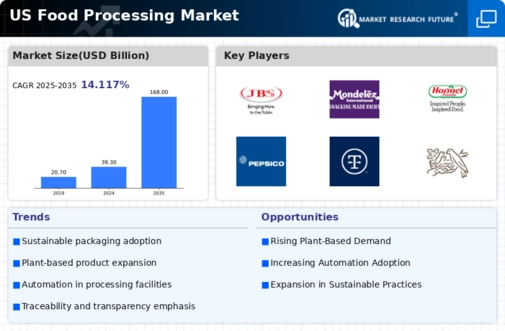Growth of Plant-Based Alternatives
The food processing market is witnessing a significant rise in the popularity of plant-based alternatives. This reflects a broader shift towards healthier eating habits. In recent years, sales of plant-based products have surged, with the market expected to reach $74 billion by 2027. This trend is fueled by increasing consumer awareness of health and environmental issues, prompting many to seek meat substitutes and dairy alternatives. Food processors are responding by expanding their product lines to include innovative plant-based options, which not only cater to vegetarians and vegans but also appeal to flexitarians. This growth in plant-based alternatives is likely to reshape the food processing market, as companies invest in research and development to enhance flavor and texture.
Rising Demand for Convenience Foods
The food processing market is experiencing a notable shift towards convenience foods, driven by changing consumer lifestyles. As more individuals seek quick meal solutions, the demand for ready-to-eat and easy-to-prepare products is increasing. In 2025, the convenience food segment is projected to account for approximately 30% of the overall food processing market. This trend is particularly pronounced among busy professionals and families, who prioritize time-saving options. Consequently, food processors are adapting their offerings to meet this demand, leading to innovations in packaging and product formulation. The focus on convenience is likely to continue shaping the food processing market, as manufacturers strive to balance quality with speed and accessibility.
Technological Integration in Production
The food processing market is increasingly integrating advanced technologies to enhance production efficiency and product quality. Automation, artificial intelligence, and data analytics are becoming essential tools for manufacturers aiming to optimize their operations. For instance, the adoption of AI in quality control processes can reduce waste and improve consistency, potentially increasing profit margins. In 2025, it is estimated that around 40% of food processing companies will implement some form of automation in their production lines. This technological integration not only streamlines operations but also allows for greater flexibility in responding to consumer trends. As the food processing market evolves, the role of technology is likely to become even more pronounced, driving innovation and competitiveness.
Increased Focus on Food Safety Standards
The food processing market is under heightened scrutiny regarding food safety standards. This scrutiny is driven by consumer demand for transparency and quality assurance. Regulatory bodies are continuously updating guidelines to ensure that food products meet safety requirements, which has led to increased compliance costs for manufacturers. In 2025, it is projected that food safety compliance expenditures will account for approximately 5% of total operational costs in the food processing market. This focus on safety not only protects consumers but also enhances brand reputation, as companies that prioritize food safety are likely to gain consumer trust. As a result, food processors are investing in better quality control measures and traceability systems to meet these evolving standards.
Emergence of E-commerce in Food Distribution
The food processing market is experiencing a transformative shift with the rise of e-commerce as a primary distribution channel. As consumers increasingly prefer online shopping for groceries, food processors are adapting their strategies to reach this growing market segment. In 2025, e-commerce is expected to account for over 20% of total food sales in the US, significantly impacting traditional distribution methods. This shift compels food processors to enhance their online presence and optimize logistics to ensure timely delivery of products. The emergence of e-commerce not only broadens market access for food processors but also allows for direct engagement with consumers, fostering brand loyalty. As this trend continues, the food processing market is likely to see further innovations in online marketing and distribution strategies.
























Leave a Comment